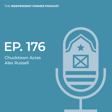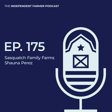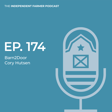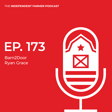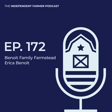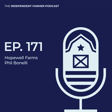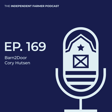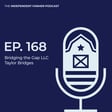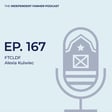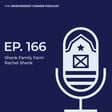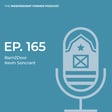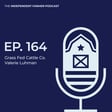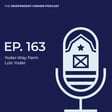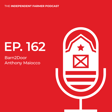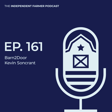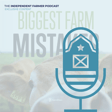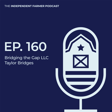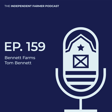Become a Creator today!Start creating today - Share your story with the world!
Start for free
00:00:00
00:00:01

Increase your Farm's Average Order Value
In this week's episode, James speaks with Peter of Bartlett Farms (ND) about how he increased his average order value by educating Buyers, selling sustainable products and offering a convenient option to shop.
For more Farm resources, visit: https://www.barn2door.com/resources
Transcript
Introduction to the Independent Farmer Podcast
00:00:10
Speaker
Hello and welcome to the Independent Farmer Podcast, the go-to podcast for do-it-yourself farmers who are taking control of their own business, skipping the middleman and selling direct to local consumer and wholesale buyers. This podcast is hosted by Barn to Door, the number one business tool for independent farmers to manage their business, promote their brand and sell online and in person. Let's dive in to today's Independent Farmer Podcast.
00:00:42
Speaker
Welcome to the Independent Farmer podcast. I am James, the Chief Operating Officer at Barned Door and your host for today's episode.
Barn to Door's Role in Farming Business
00:00:50
Speaker
As many of our listeners may be aware, Barned Door offers an all-in-one business solution for independent farmers who are cutting out the middleman, taking control of their business and selling under their brand and making sure their customers can purchase from their farm, both online and in person. In today's conversation, we're going to get into how to increase your average order. i How do you make more money with the customers you may already have?
Meet Peter Bartlett from Bartlett Farms
00:01:14
Speaker
Today, I'm happy to welcome back Peter Bartlett of Bartlett Farms in North Dakota. Peter is a part of our farm advisory network and has worked with us for about four years now. and Since becoming an advisor in the past years, he shared his wisdom of running a successful dairy farm and how to increase pricing and offer a premium product. I'm excited to talk with Peter today about what he's done to grow his business and increases or order value with his customers.
00:01:39
Speaker
So welcome back, Peter. It's great to see you. Yes, thanks for having me. Well, first off, let's start with how things are going in North Dakota this time of season. You just mentioned it's summertime in North Dakota. And how long does summer really last in North Dakota? Well, I like to extend it from what it actually is to what I like to think of it as. is Summer is anything without snow. So if you think of that, we have about seven months of summer here. It's pretty promising. If you look at it yeah in reality, June is pretty much our grazing season. By the end of September, we're pretty much wrapped up with how much we can graze. We're in north central North Dakota. So our season, even compared to most of the state is even shorter than say Fargo or Bismarck, which have a good two weeks ahead of us in the spring and in the fall. So yeah, you guys are tucked up there right close to the Canadian border fire recall looking on a map. Is that correct?
00:02:34
Speaker
Yes, yep, we're out in the middle of nowhere, but we've been able to reach the places that the populations are with our products. So we like to reframe it as if we are in an oasis where we don't expose our products to chemicals, we're away from the conventional crop farming in most of the state, and we bring our products into the population centers. That's a fantastic way to look at it. And like you said, does ensure that you guys are again, maintaining and managing your products in ah in an environment that they're not going to be infected by all those other outside pests or outside influences, et
History and Evolution of Bartlett Farms
00:03:09
Speaker
cetera. Well, for our listeners who may not be familiar with Bartlett farms, could you start first with ah just a little bit of background on on the farm when it was established? Cause I know it was fairly recent, right? And then more importantly, some of the products that you guys have today.
00:03:23
Speaker
Yeah, so I would characterize myself as a 1.5 generation farmer. My dad was an engineer at and NDSU in North Dakota State University and he had no farming background, um neither did my mom. And really through the course of studying family economics and what would be best for building a family that could work together and each one and implement their God given talents. We chose and my family chose to move to a rural place that we could establish roots in our community and build an entrepreneurial business. um At the time, my dad was more specialized in teaching and then we homesteaded on the side. So we were grazing chickens and gardens and my passion was animals.
00:04:07
Speaker
Ever since I was five years old, I could remember wanting to do something with animals. And now today my dad is really involved with the meat side of things. And then my three brothers have moved on to other things and I've gotten married and my wife and I are managing the raw milk dairy here with about 16 cows. And I have two little boys and that is our livelihood. So we're producing raw milk, delivering it to the cities around North Dakota, marketing it. mostly three to four hours away um to where the people are and then managing to make it profitable on the side of just making it sustainable. Well that is just a fantastic story. I think something that many homesteaders aspire to is to actually be able to take the idea of not just providing for yourself but
00:04:57
Speaker
more importantly, actually turning into a business that could sustain a family and provide a viable income. So well done. It's been great to see your success and your commitment to quality products and and good sustainable practices. So real quickly, you said you started with chickens. That's typical gateway drug for homestead for homesteading to get started. I always loved that. How did you spark a love for dairy? How did you get into dairy? Because dairy is also a very unique product for many people to get into. It takes a lot of time and a lot of investment. Yeah, for me, I think I have had the blessing of being interested from a young age. We were homeschooled, and so we had been exposed to other homeschool friends in our upbringing that had a farm, specifically one family that we visited when my dad was getting to know different people around the state.
00:05:47
Speaker
And they had goats and then eventually a milk cow. And we just kind of latched onto the idea of needing milk on our homestead. And so when we got started, we started with goats. We had, I think upwards of 20 goats at one point started with just a couple. And then I just, I think I'm a steady guy. I'm not into the next biggest trend. And I just started. putting myself into it. I was 15 at the time that we got our first milk cow and obviously single and didn't have a lot of expenses. So living with my parents and putting myself to the task, really believing that God called me to do something that would be of service to people. And when we realized that raw milk was an avenue to market a product that had more value per
00:06:37
Speaker
hour of work than perhaps produce. You know, when you're selling at a farmer's market, getting a dollar a pound for this and that and the other, it takes a lot to make a vegetable operation a livelihood. And so I kind of realized early on that the dairy was something that not many people were doing. It was something I enjoyed and it was something that I was good at. So putting those things together, we started as a cow share
Legalizing Raw Milk Cow Share Agreements
00:07:03
Speaker
dairy. We copied an agreement from a farm in Virginia and then had some consultations with the Farm to Consumer Legal Defense Foundation to update that and make sure it was relevant to our state. And then in 2009, we sold the first cow share for a half gallon a week to a neighbor just 10 miles away.
00:07:24
Speaker
And then from there, it just started being one thing after another. We built out a reputation. um People from Minot and Bismarck and Williston started asking us to come to their areas. In 2010-11, there wasn't very much talk about raw milk. The legal status of it was not defined. There wasn't a law saying one way or the other. It was generally thought of as illegal to do it, but we were willing to take a risk and implemented the cow share agreement, which we felt would protect us if there was any legal
00:08:00
Speaker
um question And it turns out in 2011, the state clamped down and wanted to ban it altogether by so-called clarifying it was illegal. And as a result, the lawmakers, through ah negotiations and talks with us and our customers and all the people that were willing to show up at the hearings, actually passed it into law to protect the cow share model. And so through that time onward, we saw a lot of demand, especially during the oil boom in the Bakken oil fields in North Dakota, people moving from Colorado and Washington and other parts of the country to North Dakota, finding out there wasn't very good food here and looking for farmers. They started asking for more milk and then we started delivering to these locations that were further away and charging to cover that for us.
00:08:49
Speaker
so I kind of have an advantage, I think, starting young, not having a heavy responsibility to provide for a family and getting traction early that has allowed us to maintain. But also through that process, we did learn some good marketing tactics and some things that have kept us sustainable because so many people start and then find out that cost Otherwise it's really expensive to maintain a dairy, especially fighting cold and blizzards and everything you have to deal with. Yeah. It's a great background because getting into a dairy operation, like you said, for many people, it can be pretty intimidating, but I love the fact that you were able to start small, build a sustaining basic customers and dairy by the nature of the product, it's just produced so consistently, right? That it just lends itself to building customer loyalty, right? I'm a raw milk drinker myself, right? because
00:09:44
Speaker
In my thirties, I did what many people do is I became lactose intolerant. Right. And so I quickly discovered raw milk has lactase in it. I could drink it more importantly, had all these other wonderful health and wellbeing benefits. ah In addition to being just a completely natural product, just the way God intended it. And you know what, when handled properly, it's very safe. And like you said, the farm to consumer legal defense fund has done a fantastic job. advocating across state by state to try and bring some sanity to the legal structure to permit, whether it be herd share or direct retail, even direct to wholesale in some markets, sales of raw milk, which is really great to see a resurgence of raw milk. So is raw milk, is that like the big revenue driver for your farm business today? Is it primary as a dairy?
00:10:28
Speaker
It is the main driver. I think that brings new people to
Strategies for Upselling and Pricing
00:10:32
Speaker
us. We also see a lot of consistent sales with eggs. So we've done well with that, but then also our grass fed beef is up there as well. So between multiple avenues, the dairy is probably what gets people interested because it's a unique thing that you can't find. North Dakota has a lot of ranchers. A lot of people know people that have chickens and it's not as hard to find, but then the dairy is what takes people looking for. the same thing you were dealing with, with lactose intolerance and gives them a jumpstart into looking for a local source. Yeah, that's a very big deal, right? We'll start with that because this is, I think one of the things that's so interesting about your business that probably to your point has been a competitive advantage, right? Is finding a staple product. You can get somebody to start with your farm, build a loyal customer base, build a brand, build some consistency, and then start expanding. So let's talk about that, right? So you first
00:11:27
Speaker
You attract people in, you get them started with either a one-time purchase or ideally a subscription purchase to sign up for your dairy or your herd share, like you said. Start enjoying those products. Once once you've done that, what what do you do next? do Do you just effectively try to get the buyers hooked on the milk and then try to focus on upselling, like testing different products? How how do you how do you market or do you upsell to them these other products that you have today? Yeah, well, I want to back up just a little bit because I think one of the biggest ways that it has helped us even from the get go, getting people started is to to make it very simple and break down as many barriers as you can to entry. So one thing that I see a lot of farms making a mistake on that I think is ah is not good when it comes to the cow share model specifically, but maybe relevant to other people selling with glass bottles and doing other things is they
00:12:23
Speaker
have a very complex way of explaining how to get started. So they would say, you know, here's $10 for your glass bottles. Then you need to pay me you know a paper check every month on the 15th. And then you need to show up at this parking lot at this time and get your stuff. And it becomes a very complicated thought process for a person who's just dealing with lactose intolerance to get started. And when we were getting more formalized with marketing, One of the things that we came to realize was it was at a time when a lot of service models or even not so much service models, but even product models were going over to a subscription model. So think of Adobe using Photoshop and Premiere pro or windows, you know, these used to be packages you would buy off the shelf and install in your computer. And then you would be able to run that until you needed to buy the next package and install it on your computer.
00:13:18
Speaker
Even Netflix with the streaming service Blockbuster, you'd go purchase your rental and then you'd have to return it, but Netflix made it a subscription. So what I was conscious of coming into it was I wanted to create an offering that had three tiers. So I was going to take, instead of selling it by the gallon, And i I wanted to disconnect people's mindset from thinking of price per gallon because I knew if you're going to think price per gallon, it's going to feel like it's expensive because you're going to think store bought milk to raw milk and it's you know all that. You don't want to compare apples to apples because it's truly apple and oranges. These are two truly different products and you should be paying a premium for the raw milk, right? So you by disconnecting that, not letting them, quote unquote, buy just a single gallon, you remove the price comparisons. That what you're saying.
00:14:08
Speaker
Yes. Yep. So I was thinking of it in terms of look at, you know, if you're signing up for Netflix or I'm not using that because I patronized Netflix, but I'm just saying as an example, if you have three tiers, meet large, medium and small, you go to a fast food joint too, or I was just impressed with this at a pizza shop. They call it medium, large and family size or whatever. You're not thinking price at all. You're thinking, okay, I want what's going to fit me. so When the people would come to our farm, we kind of took an average of what are they going to want. so that We said two half-gallons every two weeks was going to be a starter, a basic plan. The family plan was going to be four half-gallon bottles every two weeks. Then the large family plan was going to be 10 half-gallon bottles. so You're going to have like this spread of small, medium, and large, and it psychologically makes people think in terms of, I want the middle one.
00:15:00
Speaker
And so when they get started, they're willing to put down the middle price. And then we charged at the time, I don't remember what it was, but it ended up being $49 or $50, which was a simple dollar amount. So and rather than being, I got to pay $10 and you got back 14 plus a $5 delivery fee plus this, plus that, we just said, okay, give us $50. and will give you what most people are going to want when they have lactose intolerance. So there we've broken down all of these complicated things and we've said here's something that will solve your problem, just give us money and you'll get your solution to your problem. So that was really helpful and it continues to pay off in terms of people looking at it as
00:15:42
Speaker
I want, you know, a basic plan or a starter plan rather than I need a court every week and then I have another kid on the way. So I'm going to need another half gallon and then they're paying out more and more money per gallon. They just think of it as I want the family size solution. which is based on our data, what most people want that gets us a good average order size to begin with right out of the gate so that we can afford to deliver it to their door. And if they break a bottle, we don't have to charge them a $3 to just replace the bottle. Like there's a lot less shuffling of money to make it. Yeah. Yeah. We speak with a lot of dairies who, you know, to your point,
00:16:22
Speaker
want to find out how can I charge for a bottle deposit fee? And we're like, you don't want to charge for a bottle of deposit fee. Just build it into your price model. Like just make it easy, right? Make it up easy and convenient. Cause guess what? The second you introduce a bottle deposit fee, you're immediately going to look over conversion, right? You're going to get less sales just like that. By the way, I have one more package for you. You need to add, which is the teenage boy subscription. Cause when I had two teenage boys in my household, and we had a raw milk subscription to our door. We were getting six balls per week, right? It was just, it absolutely was not cheap, but guess what? no
00:17:01
Speaker
had healthy teenage boys who are now like 6'5 and 6'3, went into growing some strong bones and some tall sons. right so That's great. Really, really wonderful product. Thinking of order size, you do need to know your cost to think of how much does it take for me to be profitable. so Right away, we realized based on how much things cost, especially as a dairy with one or two cows to begin with, We needed enough money to be able to pay for the hay and to pay for the gas and to pay for the bottles and all these things. So you don't want to be cheap. So that's where I think it's really important to charge enough. I think that's probably, you know, with the other podcasts that I've done with you guys, I might be known for just how much we charge, you know, $25 a gallon.
00:17:51
Speaker
But in my mind, I'm thinking of it as $50 to solve your lactose intolerance problem each month. Like how many of us pay $25, $50 a month for subscriptions, even just software or cell phones. Everybody's got that in their budget. It's just a matter of how much of a priority are you going to put on it? So with that in mind, you need to have an idea of what your average order needs to be. And then it makes it simple to take who your average the customer is and go say, where do I find more of them? So for us, we were saying, if every customer is paying $50 a month,
00:18:30
Speaker
then if I have 100 customers, that's $5,000 a month. So then if you have the average customer and you know it's a middle-aged mom with one or two kids who's got this much of a mindset in health, then you can go about creating value for them, whether it's what you post on social media or whether it's where you find connections that help you find more of them. And you just start building out like a referral to say, hey, If this person likes it, if that person shares it with their friend who most likely has people at the same age, or if you have teenagers, those teenagers have friends who also have the things that they're going to be looking for lactose solutions. Then you can easily build out your business model based on your subscriptions, which are more or less guaranteed depending on how well you do it keeping customers. Yeah. So let's talk about that mom, right? We often call her suburban Sally just as a marketing persona, right? So.
00:19:25
Speaker
She cares about the health of her family. She cares about the input she's putting into her kids. She signs up for a dairy subscription with Bartlett farms, gets it delivered every two weeks. Fantastic. Now you know that she's spending money on other products as well. Um, she's got more wallet. She's got a grocery budget and you've got a portion of it. How do you now start to expand, start to capture more of the wallet share that she has today? How did you begin to introduce the other products? Did you think about the products that you wanted to sell? Did you survey your customers to gauge what other products you were going to sell? Walk me through that a little bit. If you're a farmer thinking about add-on products, you mentioned eggs or earlier, maybe that's an easy starting point. How did you start with add-on products to start expanding the wallet share and how much more revenue you can make per customer?
00:20:14
Speaker
Right. Yeah,
Listening to Customer Needs and Expanding Product Range
00:20:15
Speaker
that's good. I keep coming back to positioning and and communication of what you're going for because there's a book by Seth Godin called Purple Cow. And the concept of that is that marketing starts with the product itself. the product itself, no matter how you say what it is, you can put fancy packaging or you can do other clever marketing tricks. But at the end of the day, what the product is, is going to make more of a difference in how it sells than anything you can say about it. So in our case, one thing that we found by listening as a tactical thing for farmers listening to do would be to
00:20:57
Speaker
just be always conscious about the subtle feedback that you're getting from customers, whether it's at a pickup point where you're talking to them about what they've been listening to on a podcast or if it's a pain point that you're observing or they're saying, you know, my kid is dealing with this problem and they're going to go get their allergy test done or whatever, you know, be always taking notes because you never know when those little things add up if they're going to tell you what to do down the road. So in our case, soy free chicken feed was almost scoffed at like five years ago and nobody really believed that it would make a difference. Like what the chicken ate would change the constitution of the eggs that the customer was getting.
00:21:48
Speaker
But early on, we started hearing from our customers that they were dealing with egg sensitivities. And like one or two people might've mentioned, you know, do your chickens eat soy and or gluten grains or something to that effect. And our response was, you know, we haven't studied that. We'll look into it. And we were very early on, I think one of the first in the state to adopt a soy free, corn free, wheat free chicken feed. And to this day, that's one of the biggest questions we get from other farmers is asking us for the recipe, you know, what do you do to make this magical feed. And it's because the consumers were starting to look for it and now you go to tractor supply and you've got soy free organic feed, maybe not corn free but all of these trends that began with just a customer or two that are very up on things and doing research.
00:22:40
Speaker
that are talking to us and we were listening, we implemented that. So when we offered soy free, corn free eggs, we saw some of our best customers start buying those eggs and those eggs were about $10 a dozen. Not only was it just a good timing to get into it, but we communicated it in such a way that it was consistent with our fresh pure product brand and people could resonate with it and be willing to fork out that extra money. So I would say getting clear on what your values are.
00:23:17
Speaker
Kind of like Valerie was just doing with their content academy that you guys have been putting out, the brand and the values of your business are going to inform the choices that you make with your products. And then they're going to help you develop products that are going to attract the same buyers to buy other things from you. So yes, you can just start saying, Hey, I'm going to offer chicken eggs. But for us, especially as a farm in a rural area, we zeroed in on the brand and we really believe this ourselves. So it's not something that's artificial, but we believe that you need to feed your body so that your body can heal itself. And if your chickens are fed soy and your body is reacting to soy, then if we cut that feed, we're going to have soy free eggs and you're going to be healthier. And there you go. Yeah.
00:24:07
Speaker
Bingo. I think this is a really important point. I mean, we all know food is medicine. I heard a great sermon a couple of weeks ago at church. It was our pastor was sharing. It's like, treat your body as if you're going to live forever and treat your spirit like you're going to die tomorrow. Right. And so it's just an importance of just really investing in good health. And like you said, you're not selling just a cow. You're selling a purple cow that's worth more value, right? These soy free, corn free eggs. And it's interesting, right? You know, I think a lot of us know about other specialty products that can charge our huge premium based on on the inputs, right? I think of Eberco ham, right? The fact that pigs that are raised on acorns can command a price of $28 an ounce, right? So clearly like I'm pretty confident that if I was to drive across North Dakota and just hit a few farm stands, I'm pretty confident I could find eggs for two or $3 a dozen. The fact that you can charge $10 a dozen in North Dakota,
00:25:04
Speaker
Again, that's a remarkable testament to the branding you've been able to build. So, so well done. Right. Thank you. Yeah. And I think that everybody is going to be able to find a niche and it's not a matter of just copying other people. It's going to be, what do you understand? How do you communicate it? And ultimately it's going to be what your customers want and how you communicate it with those particular people. So you went from selling dairy, a recommended family bundle to an egg add-on, a very nice premium one. How did you get into adding on beef? Because obviously proteins we know is a strong staple, high value staple. And and you know, many of our farmers have a lot of success with, but were these dairy cattle that were aging out and you were turning them into burger or were you guys actually starting to grow a separate herd or did you source from another farmer? How did you start getting into selling beef?
00:26:02
Speaker
Well, as far as beef sales, in North Dakota, there's a lot of ranchers around and so distinguishing yourself is the hardest part. It might be similar around the country, um but I'm only familiar with our area. We started just raising a few steers that we had purchased and then realized early on that we could keep a cow and a calf and raise it to finish on grass and so I think that moving into the protein side between our beef and our pork we started like with the pork that's a little easier soy free corn free pork that was consistent with our brand it still is harder to find good quality pork than it is beef. I guess when people
00:26:52
Speaker
begin to trust you say with the raw milk and i'm speaking mainly from the raw milk side because that's my part of the business um my dad is more in the beef and pork um but the raw milk is the leader there's a reason why the dairy is in the back of the store in the grocery store because it makes you walk past everything else to get your items that are going to go bad on you versus the freezer section you can buy once and that beef stays. So if people are already coming for the dairy or the eggs and then they realize that it's convenient to to purchase the beef, I think that we've seen a lot of our dairy customers get on the beef and pork bandwagon because it's easy and it's just kind of a no-brainer. The trust that they have, if you've established to begin with that they're not price sensitive,
00:27:41
Speaker
you know, within reason, they're not going to shop just based on the cheapest available. Otherwise they'll go to Costco. If they're going to buy local, if they know you and like you and trust you, then when you start saying, Hey, I've got freezer beef available, then whatever you can do to make it easy for them makes it worthwhile for them to just stick with you. So I think that would be our biggest strategy when it comes to making a current dairy customer into a beef and pork customer would be just making sure that we communicate it
00:28:16
Speaker
To them, we are consistent with the values that we bring to our grass only beef, which is grass fed and grass finished, and then demonstrate consistency in how it's delivered to them. So if it's one thing that we moved into doing more was having an inventory of it available at all times rather than just twice a year. Some of those types of things help convince Suburban Sally to buy your beef because she might want to start with a box to test it out. And if she likes it, she might want to put it in the freezer so she knows what she has and she can plan accordingly. Yeah, that's a great point, right? Which is you've got the recurring subscription with the dairy, right? But to say, Hey, the only option is to sign up for a beef subscription. It's a bigger price point.
00:29:05
Speaker
I imagine with eggs, it's probably easier to say, Hey, let's get an egg add-on to my subscription. Right. That's a different thing. But for beef, it sounds like you're offering it as a one-time purchase. Hey, try this out as an add-on. You feature it like in a newsletter, email, social media. How do you drive awareness to it? So suburban Sally knows to upsell or add it to her car. Cause it does have her a lot of time too, right? It is more convenient. Like if she's going to get one delivery and cross this many more checks off her grocery list, it's done. Right. Yep. Yep. We don't. actually talk that much about our dairy in our content. um We've been starting to do more but for the past eight or ten years we've been always sold out and it's always been harder to produce enough milk to meet the demand. So we were toning down how much we talked about our dairy and mainly talking about our beef and pork and eggs. So I think
00:29:57
Speaker
just making sure that in every point that they come across your website, your farm store, your emails, that those are in the forefront. If they know you as the raw milk farm, but then they see you talk about your beef and your other things, they're going to eventually choose to purchase that. If they have been referred to you for the milk, then it's not as hard to convince them you won't have milk for sale. So making sure that the beef and the other packages are available and they easy to find on your site is probably the biggest thing. um I think we could do better with simplifying
00:30:32
Speaker
We have subscriptions for beef as well. Just like I mentioned, we have inventories. You could buy a pound of steaks or a pack of ground beef or whatever. But we do have a box where we call it a small, medium, and large. So that's bundled into an average of 12 pounds of ground beef, some steaks, and some roasts. So just having done it long enough, we kind of see that there is a benefit in doing kind of the curated box. approach versus just having everything available at all times. Like I would like to see us move a little bit more toward just the boxes versus having just porterhouse versus nearby versus steak. So just I'm learning as well. We haven't got that fine tuned. I would say making sure it's communicated and all your materials and even giving samples. So if people are milk customers and they haven't tried your beef, they probably don't know what they're missing. So something for us to work on too.
00:31:31
Speaker
Yeah, that's a great suggestion, right? You know, if if you've got that loyal customer that's been with you for months or even years, right? Why not just hand off and leave them an extra pound of ground beef? Say, hey, look, we're now offering beef too. You know, you can add this to your biweekly subscription if you'd like and just give them a little promo code or what have you, right? That's fantastic. And you do bring up a really great point about beef. We've seen this mistake made by other ranchers, which is trying to list everything by cut. Because what happens, you and I both know, is people will just gravitate to what they understand, which is going to be pretty much primal cuts. And then pretty soon you find out that you're in the freezer business with lots of freezer beef and lots of secondary cuts cuts and rows that you can never move. And I've never talked to a rancher who said, yeah, I want to be in the freezer business. They would all rather move the meat, right? And so your intuition is serving you correctly. We can see from the data that unequivocally the highest performing ranches go precisely down that path of
00:32:27
Speaker
on the boxes of beef, right? And entice people in the small, medium and large boxes with some of those attractive primal cuts. Yep. Every 10 pound or 20 pound box has a T-bone and the 20 pound box has a T-bone and a filet. And sure enough, there's 10 pounds of ground beef and some other cuts in there, but your goal is to move the whole animal, right? You don't want to just just not sell specialty cuts, right? A lot easier inventory management too as well. Yes. Yeah. I think that is basically the mirror image of what I was explaining with the death by nickel and diming. If it's too complicated for people to purchase milk with their glass bottles and then their bottle deposit fees, and then their cow share fee, and then all of the milk, you know, boarding fees, if that's too complicated on the dairy side, that's the same thing you're talking about with the beef side. So if you can simplify down to the average small customer, average middle customer, average large customer,
00:33:20
Speaker
that should cover everything and it'd probably do us well to simplify that even more. Tell me a little bit about working with partner farms. So you mentioned working with your dad, obviously that's probably a different type of partner than somebody you trust intrinsically. But have you worked with any other third party farmers at all who you've sold their products through to your customer base or is that something you've thought about before? It's something we've thought about. One of the challenges that we have would be the fact that we do have such a high premium on brand.
00:33:51
Speaker
we don't immediately you have people who have the same mindset that we would want to source from. but We haven't done nearly as much of that as other farms do. I do think it's an opportunity because we are running delivery vehicles all across the state. It would be easy enough to pick up inventory from people managing the warehousing of it until it can reach the other side of the state would be the challenge. So Perishable goods would be a little bit harder for us to source from another farm. My wife does do things like tallow based hand cream, goat milk, soap, home brewed kombucha. And those are in a sense, separate brands that we do sell through the barn to door site. So it does act like it would be a separate business being partnered, but it is still us thinking about the base of buyers you have today and considering that the loyalty you've been able to build.
00:34:45
Speaker
and obviously the consistent growth you've seen with your average order value. When you look at your buyers today, how do you think about again, what the Bartlett Farms brand, what it means to them, right? Like you talked about being careful about partnering with other farms because they don't necessarily share your same values or commitment to product quality. What has helped your brand stand out so much that you can command a premium? What are the values that you've written down or that you ascribe to you that has attracted this quality buyer that you guys have have built.
Bartlett Farms' Philosophy on Food as Medicine
00:35:16
Speaker
Yeah. There's a great book, Simon Sinek's start with why. And my wife and I are leaders for the chapter leaders for the Weston price foundation. And if your listeners may be familiar with that, there's a tipping point in our culture generationally, and our parents and grandparents, are you know, maybe our grandparents started
00:35:39
Speaker
eating margarine and spam and factory farm food after World War II and factories were becoming the main food production model. And then our parents were raised with that and they ended up having health issues and then they gave birth to us. And so whether it's crooked teeth or glasses or food allergies and now chronic disease like Hashimoto's and thyroid issues and all these things, we've come up to a tipping point in our day where people have to do something. And so I think what's really shaped us the most is really
00:36:16
Speaker
standing for food as medicine and bringing back the the value of traditional foods prepared in a way that is the most pure and the most helpful and the most results oriented. There's no way to cut corners and get the same results. My wife is actually a nutritional therapy practitioner and she has been able to help people with consulting from a distance to take them from having bouts of sickness to overwhelming brain fog and you know just a lack of overall wellness to use real foods like raw milk and bone and broth and just basic things that aren't that complicated. And then that has led them into a place of fertility and having children that they couldn't have before or
00:37:06
Speaker
things that are just amazing. And so our brand, one of the values that we would codify would be that food is medicine. I know it gets talked about as just a tagline, but when you realize that is what consumers want is they want beautiful, healthy babies. And the purpose of our farm, we would say is to help others raise children with less disease and and more thriving health. then that really simplifies what you're going to do to make your product stand out. So everything that it takes to reduce toxins and increase nutrients is a green light for us. So I would say when it comes to starting with the why, you know, why we're in the business of healing people, it's because people are sick.
00:37:59
Speaker
And then it moves into our method so we're going to do everything it takes to provide the least amount of toxic exposure, whether that's taking advantage of the fact that we don't have aerial chemical spray planes flying overhead, dusting our crops around here, or the waters in our lakes are pure and our wells aren't tainted like they might be closer to an urban area. we're goingnna talk about those things and we're going to make sure people know that they're getting from Bartlett Farms is something that they would stand behind and say, this is the way it should be.
00:38:30
Speaker
And then when it comes to the exact products we offer, like I mentioned, we're going to cut out the things that are causing inflammation like soy. And we're going to cut out things like chemical dewormers and we're going to stick to a mineral based using sea kelp and Redmond salt and and the trace minerals that help promote the health and our of our livestock. And then the taste is something that people don't talk about enough, but really when it comes down to when things are produced in such a way that they're healthy, our taste buds resonate with that. So all of those things I think
00:39:09
Speaker
Doing the right thing is one thing, but then getting better at communicating it is bridging the gap from where most farmers are at to where consumers are at. So when I talk to other farmers, I kind of barn to door connect call. A lot of them might be generationally brought into the cattle industry or otherwise they've always been doing it this way. It's a lot harder to change. One thing that's been an advantage for us is that we come to it as consumers more so without a history of doing it. the
00:39:39
Speaker
conventional way. So we're not s skeptical about dropping vaccines from our regimen for our livestock or doing without dewormers. We've just never had a need for it because we've rotated our pastures and we haven't developed a problem with that. So bridging the gap, one resources your listeners might find helpful is the story brand books and podcast from Donald Miller and setting it up as you are the guide to help your kind customer experience the desired outcome that they want. So rather than being like, look at us, we're saving the environment. We're doing all these cool things to make sure that we have the best land, like healing the land. You know, the suburban Sally doesn't really care if your land is healed.
00:40:30
Speaker
because she doesn't care she doesn't see it she doesn't live here but she really does care about her kids being fertile and having glowing cheeks and lots of energy and being well behaved and not having sugar highs and lows and all these things so when you get to a point where you can communicate why what you do matters to her kids then she's going to connect with that and you're going to have a person who can't find another farm in the whole region that talks about it the same way. So I think that's where you get long-term loyalty. I was telling somebody just the other day, it's fun to see 15 year old kids that were born on our products. Like it's real, like I'd get to meet them and they didn't exist when they started getting our milk. So wow wow it's amazing. Absolutely fantastic. Well, lots of wisdom, lots of great feedback, Peter.
00:41:26
Speaker
I just wanted to restate a few resources that you had mentioned earlier on. Number one is a book by Seth Godin, The Purple Cow. Great read, highly recommend it. A book called Why by Simon Sinek. Also a fantastic book. We took our entire marketing team and sales team through that same book. Just great to understand the whole purpose of why you do what you do. And then the third one by Donald Miller is the story brand. He lives here locally in Nashville. also another fantastic book that we've taken our success team through as well, which we always want the farmer to be the be the hero of our story of Bernadore. In your case, you're saying, make sure the buyer is the hero of their story, right? That server and salary really is winning and you're you're the guide to help her to achieve that nutritional benefit for her family, the health, the vitality
Advice for Farmers on Increasing Order Value
00:42:13
Speaker
of her children. So that's a really great way to put it. Before we sign off, Peter, because you and I could talk talk ad nauseam on these topics because these are all fantastic things to share. Is there anything else you'd like to discuss on this topic or suggest to farmers in terms of thinking about growing their base of sales with an existing customer? Anything else you might think of that can help them improve the average order of value that they're getting with their customers today?
00:42:38
Speaker
yeah think probably somebody tuning into this might've wanted more practical steps. I'm talking more strategy because that's where I find it does make the biggest impact. But when it comes to a practical things, definitely lean into the subscription side. um When it comes to selling somebody on, let's say a dozen eggs, if you can sell them on one dozen and that doesn't just automatically populates forever, then you've done a lot less. It takes a lot less work. So make sure you're using subscriptions to the max and then don't be afraid to charge what you're worth if you're a farm that's got
00:43:19
Speaker
low margins and your prices are low, seriously look at how much does it cost you and how much would your customers pay for you to just increase your price. That's one thing we've noticed throughout our 15 years of business or more ah is that when we would get to a point where we're like, we cannot charge $14 a gallon and stay in business, we're going to need to go to 20, then eventually 25, we would lose probably 10% but really not more than 10% of our customer base because they trusted us and they were like, well, if you need that to make yourself sustainable, I'm going to pay you for that. And so don't be afraid to raise your price and be willing to say goodbye to some of the low paying customers who might not care about you anyway. Great wisdom. Great feedback. Let's end there. Cause that is a whole nother podcast. We want to get into on pricing best practices, but that is a really important piece of
00:44:17
Speaker
feedback, like you shared, Peter, if some of the customers aren't saying no, or if they're not dropping off, you haven't raised your prices high enough, right? Because it's always easy to lower price, but it's not as easy to raise your price. So start high before going low. Well, hey, I want to extend my thanks to Peter for joining us on this week's podcast episode. You can check out more of Peter in the farm on their Instagram at North Dakota Bartlett Farms. So that's in the Bartlett Farms on Instagram. And there's two T's in Bartlett. So check out Peter and their farm. You'll see the incredible marketing activities they do to build a brand and build awareness. Here at Barnadore, we're humbled to support and serve thousands of independent farms all across the country. And we're delighted to offer services and tools to help farmers access more customers, increase sales and save time for their business.
00:45:08
Speaker
If you're an independent farmer who is just getting started or transitioning to selling direct, or if you've been at it for a while, want to simplify your business management, please visit barnadore.com, learn more. And thank you for tuning in today. We look forward to you joining us next time on the Independent Farmer Podcast. Take care, everyone. Bye-bye.
00:45:35
Speaker
Thank you for joining us on the Independent Farmer Podcast. At Barn to Door, we are passionate about empowering independent farmers to build a thriving business. To all the farmers out there, thank you for all you do to grow amazing food, care for the soil, and serve your local communities. You are the backbone of our country. For free farm resources or to listen to prior podcasts, go to barntodoor dot.com backslash resources. We hope you join us again and subscribe to the Independent Farmer Podcast wherever you stream your podcasts. Until next time.
